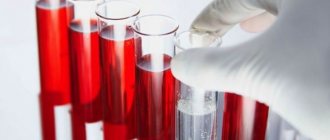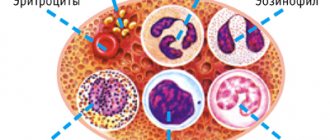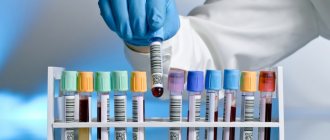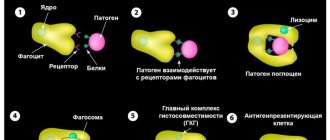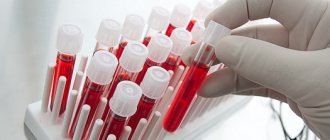Indications
- Determining the cause of prolonged vomiting, diarrhea, respiratory and heart rhythm disturbances, weakness;
- Suspicion of acidosis or alkalosis;
- Diagnosis and assessment of the effectiveness of therapy for electrolyte imbalance in the body;
- Assessment of the risk of developing electrolyte imbalance during treatment;
- Diagnosis of diseases of the kidneys and adrenal glands, heart and blood vessels;
- Monitoring of treatment results and prognosis of diabetes insipidus, heart failure, arterial hypertension.
Symptoms that may be causing increased chlorine levels:
- weakness, lethargy,
- breathing disorder, accompanied by rare, deep and noisy breaths.
- increased heart rate,
- swelling of tissues,
- increased blood pressure.
An increase in chlorine concentration (hyperchloremia) is observed with dehydration and/or impaired renal excretory function.
With reduced chlorine, symptoms may be as follows:
- increased irritability,
- tetany (painful muscle contractions similar to cramps)
- slow breathing,
- decrease in blood pressure.
Specialists who can interpret the results of the analysis: therapist, nephrologist, urologist, cardiologist, gastroenterologist, nutritionist, endocrinologist, traumatologist, neurologist, general practitioner.
Low chlorine levels: causes, symptoms and signs
Pressure surges are not a specific sign of hypochloremia
A person sometimes experiences low levels of chlorine. This condition may also indicate dangerous pathologies. Most often, the cause of this phenomenon is pathologies of the gastrointestinal tract of an inflammatory nature. The complete exact picture of chlorine deficiency in the human body has not yet been determined, but the most characteristic manifestations of the condition are:
- severe exhaustion leading to anorexia;
- insufficient urge to defecate;
- hair loss;
- loss of teeth (in especially severe cases);
- swelling;
- constant pronounced surges in blood pressure;
- alkalosis.
If at least some of the symptoms of the disorder appear, it is necessary to undergo an examination, including identifying the level of chlorine in the blood.
Blood chlorine levels
Important! Standards may vary depending on the reagents and equipment used in each particular laboratory. That is why, when interpreting the results, it is necessary to use the standards adopted in the laboratory where the analysis was carried out. You also need to pay attention to the units of measurement.
Reference values in the Invitro network of independent laboratories:
| Patient age | Chlorine level, mmol/l |
| 0 – 4.3 weeks | 98 – 113 |
| 4.3 weeks – 90 years | 101 — 110 |
| Over 90 years old | 98 – 111 |
Chlorine standards in Helix laboratories:
- 98 - 107 mmol/l.
Note:
The concentration of chlorine in the blood serum is always analyzed in conjunction with indicators of other electrolytes, in particular sodium, because An increase in chlorine values is accompanied by an increase in sodium levels.
How is the analysis carried out?
In order to determine increased or decreased chlorine in the blood, it is taken from a vein on the elbow or the inside of the wrist. The choice is up to the nurse performing the test and depends on the availability of the vein. Blood is taken using a special syringe or thin needle and test tube after antiseptic treatment of the skin in the puncture area. The entire procedure for collecting material takes 2-3 minutes. The collection is carried out on an empty stomach from 8 a.m. to 12 noon.

The resulting blood is centrifuged to separate the plasma. This is necessary in order to obtain blood serum. Chlorine is isolated in the serum using special compounds. Then the amount of chlorides is determined. Based on the results of the analysis, additional examination or treatment may be prescribed if the cause of the pathological disorder in the blood is known.
- Blood cholesterol levels - table by age. Cholesterol in the blood - norms for women, men and children
Hyperchloremia (increased chlorine)
- Dehydration of the body as a result of insufficient drinking regime;
- Excessive intake of chlorides from food (increased consumption of table salt);
- Dehydration of the body due to prolonged diarrhea associated with metabolic acidosis and intense loss of sodium bicarbonate;
- Acute renal failure;
- Chronic kidney pathologies: nephrosis;
- nephritis;
- nephrosclerosis;
- renal tubular acidosis
- diabetes insipidus;
Foods rich in chlorine
Since chlorine enters the body from the outside, in order not to increase its level to dangerous values, you should not consume foods rich in it in large quantities. These include:
- buckwheat grain,
- rice cereal,
- peas,
- eggs,
- fatty sea fish,
- crucian carp
Also, speaking about how to lower the level of chlorides in the blood through nutrition, it should be noted that table and sea salts retain fluid in the body and prevent the timely release of chlorine, which is why its normal concentration in the body is exceeded. It is especially necessary to monitor nutrition for persons with predisposing factors for high levels of this substance in the blood.
Hypochloremia (low chlorine levels)
- Insufficient intake of chlorine from food;
- Poor absorption in the stomach;
- Extrarenal loss of chloride (vomiting, diarrhea, increased sweating);
- An increase in the volume of extracellular fluid (water intoxication, manifested by tissue swelling);
- Congestive heart failure;
- Polyuric stage (gradual increase in diuresis) of renal failure;
- Chronic respiratory acidosis;
- Metabolic alkalosis;
- Diabetic ketoacidosis;
- Syndrome of inappropriate secretion of antidiuretic hormone;
- Aldosteronism (Conn's syndrome - increased secretion of aldosterone by the adrenal glands);
- Acute intermittent porphyria (hereditary damage to the peripheral and central nervous system);
- Damage to the hypothalamus as a result of head trauma;
- Overdose of diuretics (diuretics);
- Taking laxatives.
Important!
A sharp decrease in chlorine content is a sign of the development of a rather serious human condition - metabolic alkalosis and can lead to death.
Sources:
- Data from the independent laboratory Invitro, 2021
- Data from Helix Laboratory, 2021.
- Ghassan Kamel, MD. Chloride, - English-language database of current medical data Medscape, 2021.
- Joshua L. Rein. “I don't get no respect”: the role of chloride in acute kidney injury, - Renal Physiology American journal of physiology, 2021.
- Glenn T Nagami. Hyperchloremia - Why and how, - data from the US National Library of Medicine PubMed, 2021.
Functions of the main extracellular anion
Considering that the described chemical element is busy solving important problems, the body will feel when chlorine in the blood is increased or its level is unacceptably decreased. Fluctuations in one direction or another from the designated boundaries will certainly affect the state of human health. Normal chloride content is necessary to ensure the full functioning of many systems:

- Present in all types of tissues and in any organ of the human body, chlorine is directly involved in many physical processes and chemical reactions, and is the main element of water-salt metabolism, where it “works” together with potassium (K+) and sodium (Na+). To establish the water-salt balance, chlorine “makes sure” that the volume of available liquid does not overwhelm the human body and, at the same time, that it does not suffer from a lack of water, that is, it ensures a certain constancy. Due to such work, swelling goes away, including that caused by cardiac pathology, blood pressure returns to normal;
- The chlorine anion (Cl–), which is essential for a living organism, maintains the acid-base balance (plasma ↔ red blood cells). Being an osmotically active substance, chlorine regulates the osmotic balance (blood ↔ tissue), which ensures the removal of excess fluid (water) and excess salts, mainly, of course, sodium chlorine (NaCl), and also retains and redistributes them if necessary . Thanks to such abilities of chlorine, constancy of osmotic pressure in the body is achieved;
- By improving the functionality of the detoxification organs (liver), chlorine participates in the removal of unnecessary, waste products (slags) from the body, and also helps remove urea from the intercellular fluid;
- Everyone knows the participation of this element in the process of digesting food in the stomach, because Cl together with hydrogen (H) forms hydrochloric acid (HCl), which, in turn, is the main component of gastric juice. In addition, chlorine stimulates appetite and increases the production of the pancreatic enzyme amylase.
Based on the functional responsibilities of the described chemical element, we can conclude that any deviations from the norm (insufficient amount or increased chlorine in the blood) will be accompanied by troubles for the whole organism.
Intake and excretion
The consumption of chlorine, unlike other elements, has not been determined by experts, but it enters the gastrointestinal tract with food, therefore, using table salt when preparing food, a person unnoticedly provides his body with chlorine reserves. Another thing is a salt-free diet, in such cases you will feel a lack of sodium and the chlorine level will be reduced.

Almost complete absorption of sodium chlorine occurs in the small intestine. The chlorine anion there finally leaves the table salt molecule. Then (through repeated reabsorption) it leaves to be evenly distributed in the fluids filling the intercellular space.
Chlorine is excreted, like other elements, mainly through the kidneys (141 – 310 mmol Cl is removed per day). True, some of it leaves the body through the skin during sweating, but it is so small that it is not particularly taken into account.
The study of chlorides in urine can only otherwise have clinical significance (when the analysis is considered in conjunction with other indicators) and be a useful laboratory test that provides information about the level of Cl in organs and tissues.
The level of chlorine in the urine may be reduced if its concentration in the blood is less than 95 mmol/l.
Some pathological conditions can cause an increase in chlorine in the urine
- Addison's disease (by the way, in this situation, although chlorides in the urine tend to increase, a low level of the element is noted in the blood);
- Dehydration;
- Starvation diet;
- Taking diuretics;
- Poisoning with salicylic acid preparations.
At the same time, one should still take into account the fact that in the glands of the gastric mucosa and the bones of the skeleton, the concentration of this element is several orders of magnitude higher than that in serum, urine or other biological fluids.

